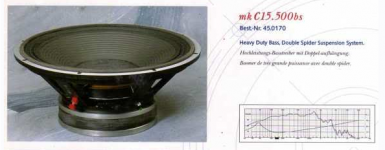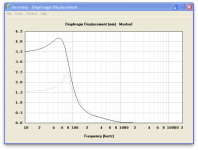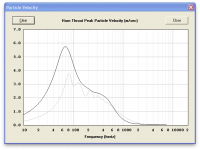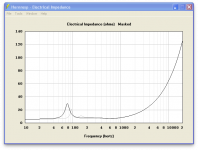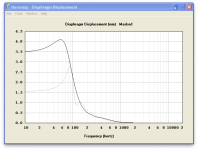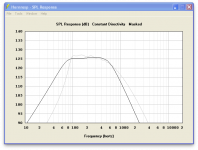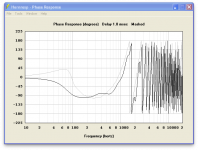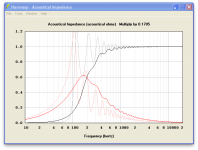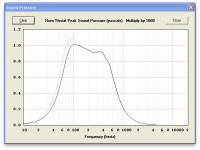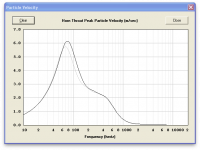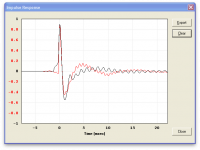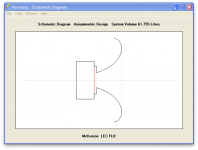Have simulated a mid/upper bass horn that will cover 80hz to approximately 5-600hz.
The driver is a 15" inch McKenzie MKC 15.500BS. First time simulating in Hornresp (bare with me), so feedback is welcome before I am cutting wood.
I will make it a round horn, due to the other horns that will be a mid LeCleach and a tweeter horn LeCleach.
Why hyperbolic and not LeCleach? Well, size actually matters, and as I have understood the hyperbolic will load down to Fs, and I need that to integrate with my two JBL 2245H subs that will cover the lower octaves in both music and movies.
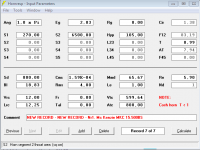
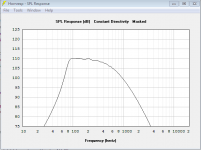
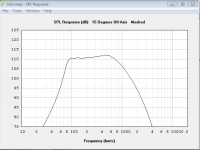
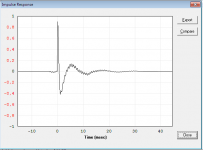
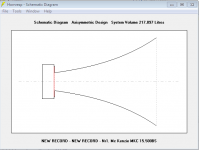
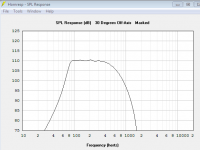
The driver is a 15" inch McKenzie MKC 15.500BS. First time simulating in Hornresp (bare with me), so feedback is welcome before I am cutting wood.
I will make it a round horn, due to the other horns that will be a mid LeCleach and a tweeter horn LeCleach.
Why hyperbolic and not LeCleach? Well, size actually matters, and as I have understood the hyperbolic will load down to Fs, and I need that to integrate with my two JBL 2245H subs that will cover the lower octaves in both music and movies.






That's not very small...
Try this:
😉
Try this:
Code:
ID=28.00
Ang=1.0 x Pi
Eg=2.83
Rg=0.00
Fta=179.75
S1=232.26
S2=7272.02
Lec=29.02
F12=200.00
S2=0.00
S3=0.00
L23=0.00
T=1.00
S3=0.00
S4=0.00
L34=0.00
AT=17.97
S4=0.00
S5=0.00
L45=0.00
F45=0.00
Sd=800.00
Bl=18.83
Cms=1.59E-04
Rms=4.00
Mmd=65.67
Le=1.00
Re=5.90
Nd=1
Vrc=30.00
Lrc=20.00
Ap=0.00
Lpt=0.00
Vtc=2250.00
Atc=880.00
Pmax=100
Xmax=5.0
Comment=Example LEC FLHI am not quite sure I follow you, NEO Dan? Not very small? Diameter about 90cm and lenght 105cm, just right 🙂
Ok, done it. What an SPL response 😱 But, if I have typed it right it seems the horn is 92cm in diameter and just 28,7 cm long?? How in the world can this horn load down that low? Everything I have read, uptil now, says that a LeCleach should be XOed an octave above the horns cut-off? The LeCleach 200 from Autotech is 96cm in diameter, and should be cut off by 350-400hz.
Please enlighten me!
Edit: what did you mean by "see it done in 62l"?
Please enlighten me!
Edit: what did you mean by "see it done in 62l"?
Last edited:
I think that what you read about the cutoff and crossover would apply to HF and mid drivers where there is little if any control provided by the rear chamber volume, but in this case we can clearly model and adjust for this situation.
The system volume reported by Hornresp is < 62 liters so it is significantly smaller.
I have some concern about your driver, the low mms suggests a very thin cone so please take care in operation. If you are interested I am willing to help with some further details.
The system volume reported by Hornresp is < 62 liters so it is significantly smaller.
I have some concern about your driver, the low mms suggests a very thin cone so please take care in operation. If you are interested I am willing to help with some further details.
A little typo in post#2, will not change anything but please adjust ATC to be the same as driver SD = 800. 800 seems a bit small, the surround would be very wide/wider than average anyway. I've never heard of McKenzie before, do you have any pictures of these drivers?
I am more than happy, if you will provide me with more information on this build 🙂
Btw: Is this type of LeCleach horn measured to go this low by any, or is it just simulations? I have never seen or heard anyone that has tried this.
I didn't think the backchamber could be used to tweak the respons this way either, guess I am learning something every day 🙂
Btw: Is this type of LeCleach horn measured to go this low by any, or is it just simulations? I have never seen or heard anyone that has tried this.
I didn't think the backchamber could be used to tweak the respons this way either, guess I am learning something every day 🙂
The rear chamber and throat chamber are simple in design but they will require some detailed measurements from your drivers. Most complicated would be the cone volume. The easy method would be to place your driver in a plastic bag like a garbage bag then fill the cone with something light weight like beans or rice. Most fun if done without explanation in front of spouse 😀 Also detailed measurements of the driver OD, mounting dia., mounting depth, and overall depth.
Robust looking driver!
Robust looking driver!
Attachments
Last edited:
Longer & Lower Maybe?
Hi S,
I recommend you explore use of a slightly longer horn if your high pass filter is to be set at 80 Hz. and 24 dB/oct. [fc] should be near 60 Hz or lower. This may be achieved by implementing a beneficial reduction in throat diameter. From there, an equivalent Le Cleach Horn may be developed by using a lower still [fc] and [T] that yields the same length horn. The benefit here will be a lower mouth reflectance. Of course the horn mouth will be larger due to lip curling.
Regards,
WHG
Have simulated a mid/upper bass horn that will cover 80hz to approximately 5-600hz.
The driver is a 15" inch McKenzie MKC 15.500BS. First time simulating in Hornresp (bare with me), so feedback is welcome before I am cutting wood.
I will make it a round horn, due to the other horns that will be a mid LeCleach and a tweeter horn LeCleach.
Why hyperbolic and not LeCleach? Well, size actually matters, and as I have understood the hyperbolic will load down to Fs, and I need that to integrate with my two JBL 2245H subs that will cover the lower octaves in both music and movies.
Hi S,
I recommend you explore use of a slightly longer horn if your high pass filter is to be set at 80 Hz. and 24 dB/oct. [fc] should be near 60 Hz or lower. This may be achieved by implementing a beneficial reduction in throat diameter. From there, an equivalent Le Cleach Horn may be developed by using a lower still [fc] and [T] that yields the same length horn. The benefit here will be a lower mouth reflectance. Of course the horn mouth will be larger due to lip curling.
Regards,
WHG
I am more than happy, if you will provide me with more information on this build 🙂
Btw: Is this type of LeCleach horn measured to go this low by any, or is it just simulations? I have never seen or heard anyone that has tried this.
I didn't think the backchamber could be used to tweak the respons this way either, guess I am learning something every day 🙂
I've not built it, but I did put lots of time into the details... Your woofer just happens to work well in my design.
The model is as valid as yours, there is no cheating in Hornresp 😀
You see the drver is doing more work and is going to move more air(@100w):
Attachments
The model is as valid as yours, there is no cheating in Hornresp 😀
Hi Dan,
Just a word of caution - by using Ang =1.0 x Pi you have assumed that the horn is tightly coupled in a wall / floor position and is radiating into quarter space only. This is unlikely to be the case in practice for a fully-formed mid / upper bass axisymmetric Le Cléac'h horn having a mouth Fta of 180 degrees.
In the circumstances it may be safer to assume a solid radiation angle of 2 Pi, or perhaps even 4 Pi just to be sure.
Kind regards,
David
Hi David,
I had swithched it to 1Pi for an apples to apples comparison, it's still good at 2 Pi that's what I had intended it for.
I had swithched it to 1Pi for an apples to apples comparison, it's still good at 2 Pi that's what I had intended it for.
Attachments
Last edited:
Will try to simulate this. I guess you think of the mouth reflectance in regards of the LeCleach horn (which are known for this)? I don't mind the lip curl, or the diameter of the horn to be big, as long as it doesn't go very much beyond 95cm, because of space. It would also be nice actually that the mid/upper bass horn is a bit bigger than the mid horn, because of aesthetics. I like the look of AG Trios.Hi S,
I recommend you explore use of a slightly longer horn if your high pass filter is to be set at 80 Hz. and 24 dB/oct. [fc] should be near 60 Hz or lower. This may be achieved by implementing a beneficial reduction in throat diameter. From there, an equivalent Le Cleach Horn may be developed by using a lower still [fc] and [T] that yields the same length horn. The benefit here will be a lower mouth reflectance. Of course the horn mouth will be larger due to lip curling.
Regards,
WHG
Not bad 🙂 But, if this horn is only 28cm deep. How will this then affect the mid horn, as I can imagine this would actually be longer? I am going to XO active, so time alignement of the drivers would not be critical as I can delay it.I've not built it, but I did put lots of time into the details... Your woofer just happens to work well in my design.
The model is as valid as yours, there is no cheating in Hornresp 😀
You see the drver is doing more work and is going to move more air(@100w):
Thanks for looking into this thread, David. First of all: Thank you very much for your efforts in making this program free to us all! 🙂Hi Dan,
Just a word of caution - by using Ang =1.0 x Pi you have assumed that the horn is tightly coupled in a wall / floor position and is radiating into quarter space only. This is unlikely to be the case in practice for a fully-formed mid / upper bass axisymmetric Le Cléac'h horn having a mouth Fta of 180 degrees.
In the circumstances it may be safer to assume a solid radiation angle of 2 Pi, or perhaps even 4 Pi just to be sure.
Kind regards,
David
I guess I should have calculated the horn in 2Pi. It will stand on the floor, but I guess it will not "be tightly" connected to a wall, but rather stand a little aside from it. I guess tightly connected to the wall, means that the horn will use the wall as a "lenghtening" of the horn itself?
Tried to sim the horn a little longer, as Whgeiger suggested. Have not optimized it (short of time), but can not yet get the SPL to be as nice as in NEODan's sim. Seems to be going lower though. Must work more on that.
Edit: I see that I have entered the same mouth flare as earlier. Will do another sim later...
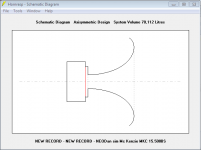
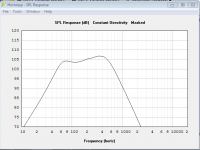
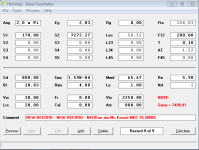
Edit: I see that I have entered the same mouth flare as earlier. Will do another sim later...



Last edited:
- Status
- Not open for further replies.
- Home
- Loudspeakers
- Multi-Way
- Hyperbolic mid/upper bass horn
